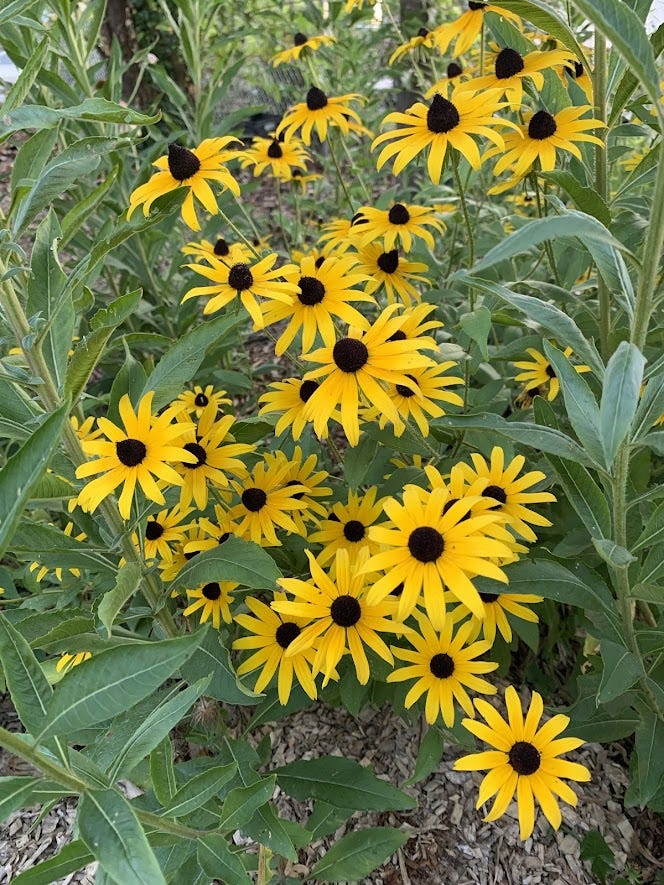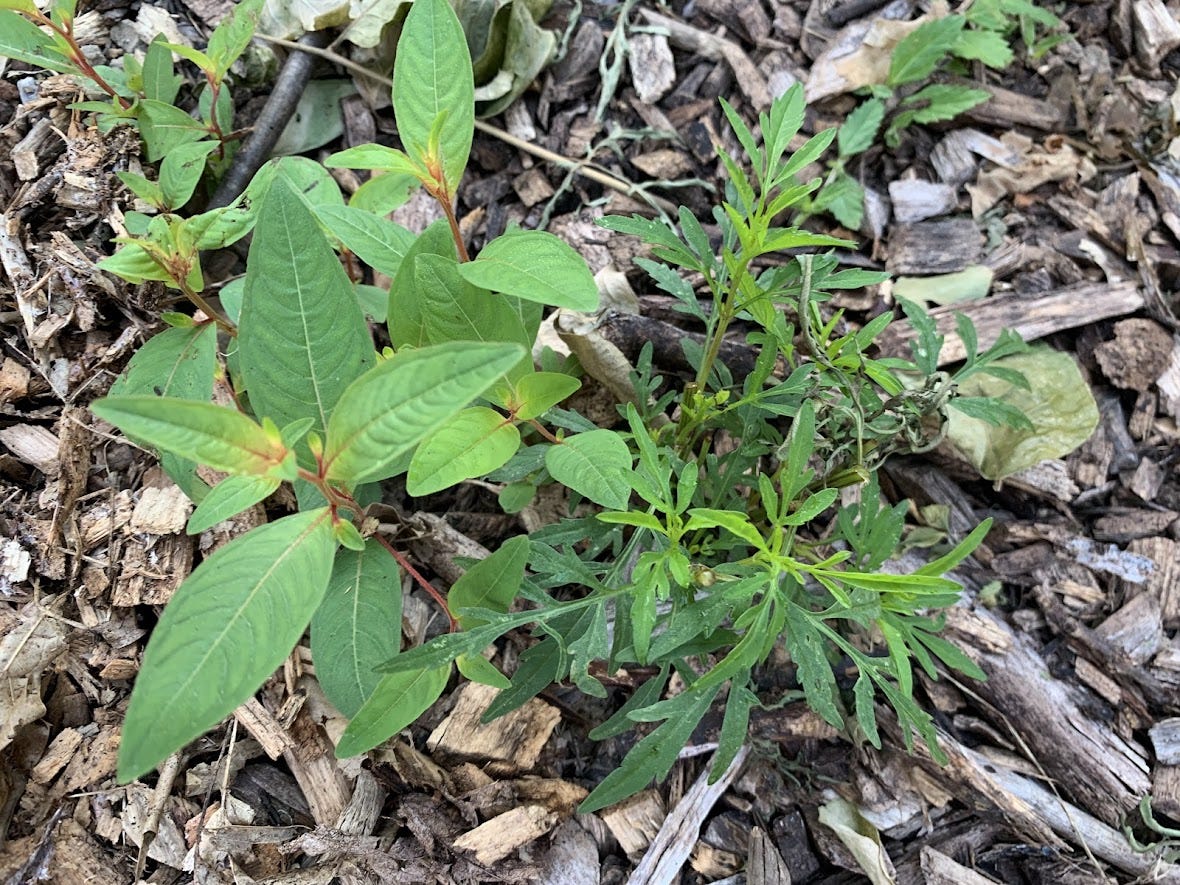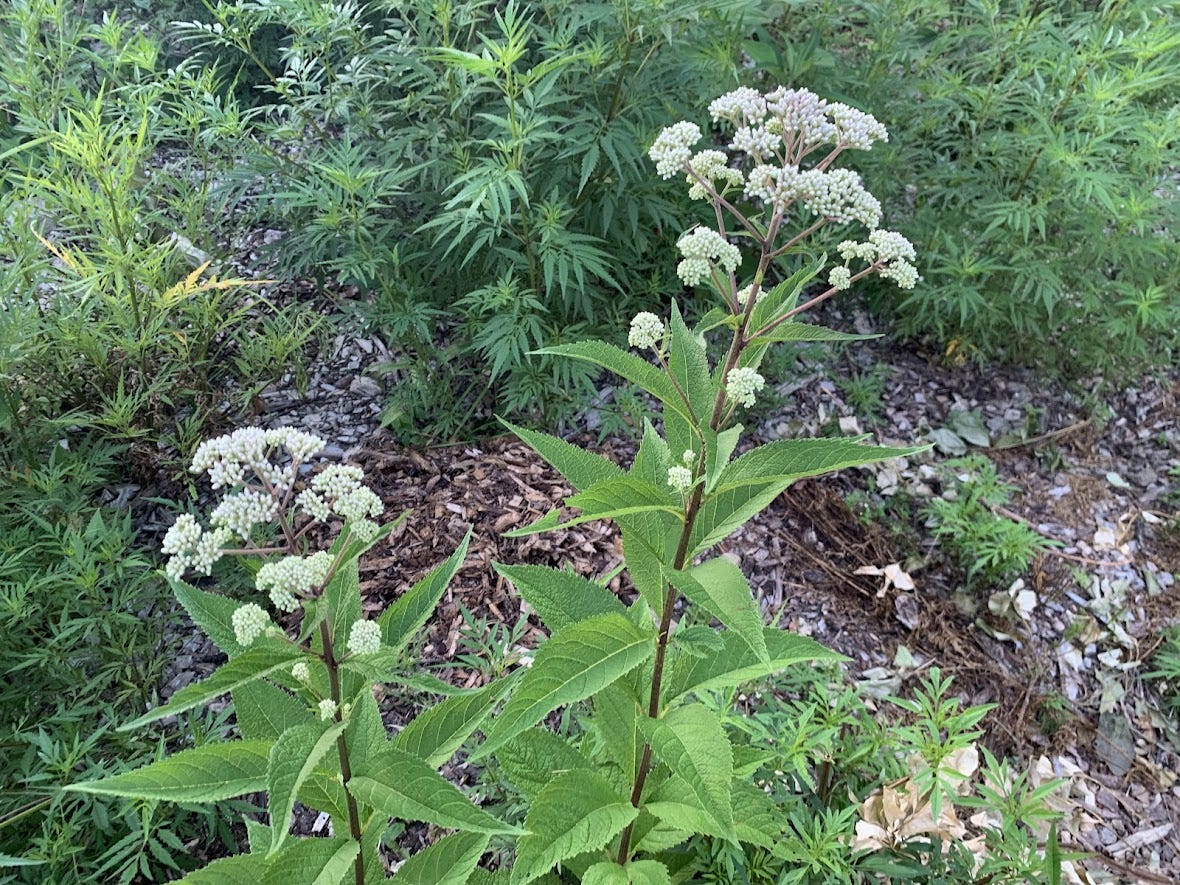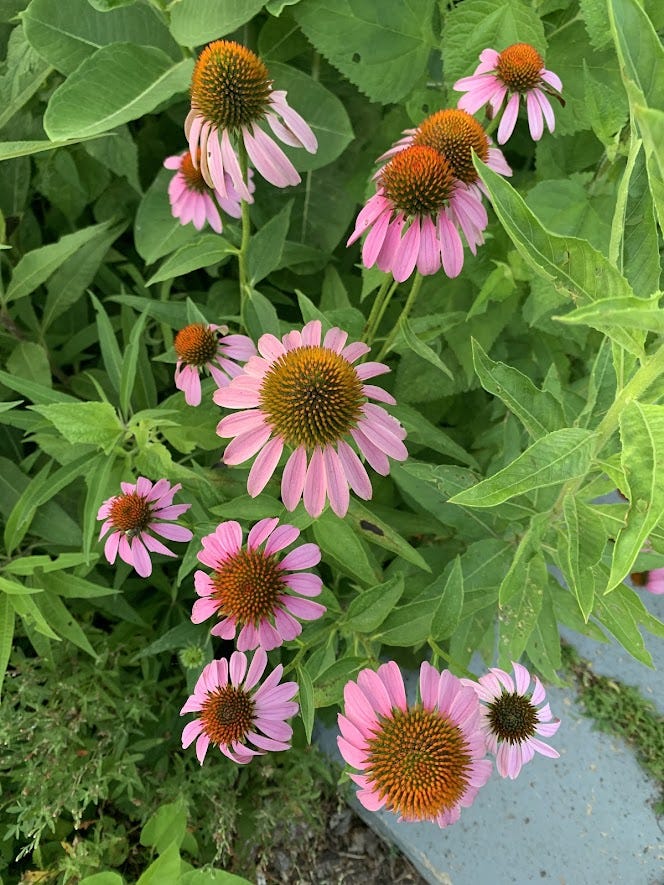Landscaping for Habitat, Soil Health & Flood Control
Choosing plants that do most of the work for you; why crowding is good; how to capture rainfall
A friend and student asked me what to do with a particular property that had a few acres, including some bare dirt that needed erosion control.
In the way of reply, I felt compelled to share my gardening methods generally, and that is what I’ve spelled out here, along with current pictures of my native home landscape in Louisville, KY.
This should be of interest to anyone who seeks to create habitat for bees, butterflies and birds, with the additional benefits that go along with that, including flood control, drought prevention as well as the ability to prevent erosion and improve the soil, for maximum plant health.
So here goes.
My goals
On my property, I want to create maximum habitat for bees, butterflies, birds, etc., which involves selecting plant species that are especially beneficial to native pollinators, caterpillars and birds.
But in addition to selecting the right plants, I seek to create a landscape that captures the rainfall, thus making water available to the plants, the pollinators, the fungi and the whole soil food web.
A landscape that makes water available to the plants, is going to grow more plants with less added water from the hose. Maximum plant matter will capture rainfall and improve the soil, making the soil absorbent of rainfall and reducing erosion.
But these are all my goals. And my goals allow for some “weeds.” If someone does not want "weeds" that is problematic, because wildflowers are weeds to some people. Ironweed, jewelweed, Joe Pye weed and milkweed are all valuable native plants that are thought to be “weeds.”
And my goals involve not artificially limiting the height of my plants. If someone wants to limit the height for aesthetic reasons, this is problematic, because that limits the amount of plant matter you can have, because you are cutting everything down. It limits the diversity, because it kills plants that need to grow taller than a few inches.
In other words, mowing or other height control methods eliminate the plants that provide habitat, native diversity and deep roots.
So … how do you avoid mowing, while building a native habitat?
My approach
My standard approach is to bring in tons, literally tons, of free wood chips from chipdrop.com. This is mulch, meaning it provides weed control. It conserves moisture. And over the course of time it decomposes, providing fertility.
After putting down 6-8" of mulch, I will plant wildflowers. I get my wildflowers free from the network of native plant people in my community. I also plant seeds in pots in January, which provides a lot of free plants.
Let the plants do the work
If you select the right plants, they will do most of the work for you. Give your plants a year. Anything that blooms and goes to seed will produce volunteer progeny, and will do much of your work for you. Some plants will sprout in places that are very useful. Others may need to be moved because they are not in an ideal place.
But I allow crowding. Crowding allows for maximum plant matter and maximum plant diversity, both of which are consistent with my goals.
This is an example of the type of crowding and diversity that I like.
This is my front yard. I planted it four years ago. It contains only plants that I have obtained for free from friends, or planted from seed myself. Pictured here are: Rattlesnake master, purple coneflower, white wingstem, common evening primrose, milkweed and blunt mountainmint.
As time goes on, this area needs less and less maintenance, because the plants strike a balance with one another. I help a little by removing some of the more dominant plants, but surprisingly little labor is required over the course of the year.
Plant species that do the work for you
I have identified a few plant species that are prolific without being overly aggressive. These are the plants that do a lot of the work for me. Anything that volunteers is something that I do not have to plant, thus saving labor.
For sunny areas, I plant common evening primrose, white snakeroot, swamp marigold and yellow wingstem. For shady areas, I plant white snakeroot (sun or shade), jewelweed, waterleaf and zig zag goldenrod. These are species I use to rapidly fill up a space.
I want plants that rapidly fill up a space, because that means maximum habitat, maximum diversity and maximum roots in the ground to improve the soil, making it more absorbent and reducing runoff and erosion.
That’s why it makes me a little ill to see landscapes, including native landscapes, that, by all appearances, are designed to be dry. Why do you design a landscape to be dry? There is no good answer. So why do people do it? Because they don’t know the value of 1) wood chips, 2) good soil and 3) plant density.
You don’t have to memorize this as long as you are following my work, because I will continue to emphasize these points. The easiest way to follow my work is to visit Free Webinars, and sign up for anything that interests you.
Can we “set it and forget it”?
The method described above is neither the hardest nor the easiest form of gardening. It is a form of gardening that requires some time and attention. I don't have an approach to gardening that is "set it and forget it." If you want to forget about your garden, then you need to hire cheap labor that uses a lot of cheap fossil fuels. But--respectfully--that will never give you optimal habitat, flood control or soil health.
*****
My students also asked about using a seed mix that includes bluegrass and fescue. Here is my response.
When it comes to erosion control, maybe fescue and bluegrass are fine. But these are not good species for creating habitat. If you're grazing cattle, the cattle can eat them enough and spread around valuable native species for habitat. But if you don't have grazing animals, fescue and bluegrass will take over and displace most wildflowers that can provide habitat. For example, ground nesting birds like quail and meadowlarks cannot live in fescue and bluegrass.
It all depends on your goals and your resources. Habitat takes time and attention. And wildflowers may not be consistent with someone's aesthetic tastes. Sometimes mowing is an essential management tool, because it is quick and simple, and it keeps things to an acceptable height. But my methods do not involve mowing, except for a little strip between the sidewalk and the street.
Below are some recent photos from my garden, intended to illustrate some of the ideas discussed above.
*****
This is my hibiscus plant.
I grew this from seed, starting in 2022. It it surprisingly easy to grow from seed. But it was in its third growing season, last year, before it bloomed. Some of my other specimens are blooming in their second year.
This is my vacant lot, three doors down from my house.
Most of the green you see here is swamp marigold, which is one of the plants that spreads rapidly without being overly aggressive or hard to deal with.
I acquired this property in May 2024. My goal is for this sunny area to be 90-100% covered with green plants by September of next year. If I can accomplish this goal, that will lead to maximum photosynthesis, maximum plant growth, maximum habitat and maximum soil health.
Here are some brown-eyed Susans mixed in with yellow wingstem.
Brown-eyed Susan is rugged and vigorous, but not terribly prolific. That’s why it is not on my list of prolific plants, named above.
This is seedbox next to swamp marigold.
It is good to have a diversity of plant roots growing together. This is good for soil health, more so than having only one plant species in any given place.
This is partridge pea.
Partridge pea is another fast spreader that will do most of the work for you, without being difficult to pull if it spreads too much for your taste.
This is false sunflower.
False sunflower is one of the species that is good for specialist pollinators.
Here is an excellent video that enumerates the 15 plant groups that support specialist pollinators.
15 SPECIALIST POLLINATOR PLANTS for the Garden — Ep. 129
This is Joe Pye weed in the foreground, with swamp marigold in the background.
The swamp marigold is a prolific annual that is helping me fill up this space with lots of green, lots of photosynthesis and a diversity of living roots in the ground, which is great for the soil.
I planted both the Joe Pye weed and the swamp marigold just last year. Do you see brown in the picture? I love my brown wood chips, but I don’t want to see them next year. I want them to be overshadowed by green plants.
This is frog fruit in the foreground and swamp marigold in the background.
The frog fruit serves as ground cover, reaching a height of less than six inches and covering the ground with green. If I strategically spread my frog fruit, then that will further my goal of covering the entire area with green leaves. Common violets and Virginia creeper are also native plants that make good ground cover.
Here is some hibiscus that I am growing from seed.
Here is some more swamp marigold.
This photo shows how the swamp marigold can fill up a space with green. You see additional plants in the bottom center and the bottom left. These are living roots in the ground that tend to improve the soil. And then, if I need this space, I can pull them and plant whatever I want in the same space.
It is a good strategy to let a swamp marigold plant grow into mid-season and then pull it to plant something else. After all, we don’t have infinite space, so we have to make tradeoffs. There is a time to pull one plant and replace it with another, especially if it is an annual that is easy to pull.
Swamp marigold is an annual, so it’s only going to last one growing season anyway. And when you allow the plant to grow for a few months, it has served to improve the soil in the meantime.
Here is a pair of cup plants.
They will not bloom this year, but will bloom next year. By the third year, they will be growing seven to ten feet tall, sporting yellow blooms.
Hummingbirds feed on many different blooms, including cup plant.
Pictured below is a cup plant with water pooling next to the stem, which it does for days after a rain.
I routinely see wasps drinking water from these little pools. And I see hummingbirds drinking nectar from the flowers.
Here are some of my purple coneflowers.
Bumble bees like these blooms. And then when the seeds form, goldfinches will feast upon the seeds.
Here is a video of a bumble bee feeding on purple coneflower.
If you enjoy this content, please visit my website for a continuously updated list of my Free Webinars. There you may click on the links that interest you.
For your convenience, here are some upcoming events.
Your Climate Friendly Backyard
Date: Friday, July 18 at 3:00-4:30 PM
What is a climate friendly backyard? What does it look like? What does it do? In this free webinar, I show you same-day pictures of my Kentucky pollinator garden and forested landscape, featuring both sun-loving wildflowers and shade. I’ll explain how these plants and trees, together with free wood chips, are busy absorbing not only carbon but water, with water, plants, trees and soil being the unsung heroes that positively impact our climate locally and beyond.
RSVP:
Your Climate Friendly Backyard Wednesday, July 18 at 3:00-4:30 PM
https://docs.google.com/forms/d/1eq0F_Oa6Kn0Rpsijnd018V95eZ_AHIrlwC5HRoYvh-U/edit
Biomass Energy: Fact & Fiction
Date: Wednesday, July 16 at 7:00-8:30 PM
“Biomass Energy” is code for burning trees. It is heavily promoted as “renewable energy” by the United Nations, by national governments, by the timber industry and by high profile climate celebrities.
What is biomass energy, and how does it work? Why does the United Nations consider Biomass Energy with Carbon Capture & Storage (BECCS) to be an essential strategy in the transition to renewable energy?
RSVP:
Biomass Energy: Fact & Fiction, Wednesday, July 16 at 7:00-8:30 PM - Google Forms
https://docs.google.com/forms/d/14rKZFKowAjzyMWFjaGVD0sjbsPP7ZDaXpgFkWJ_beKY/edit
Wildlife Decline & Climate Change
Date: Monday, July 21 at 12:00-1:30 PM
Ask the average environmentalist, “What is the greatest threat to wildlife?” They will reply, “Climate change, of course!” And they will be wrong.
Wildlife populations are seriously threatened, but not by climate change. To address wildlife decline, we need to understand the real threats and not be misled by platitudes.
We will examine a pair of articles that argue persuasively that we are being led down the wrong path and that some of the dubious “solutions” to climate change actually harm wildlife.
We will hear from conservation biologists who tell us the following: That climate change, at present, is not the most serious threat to wildlife populations; that habitat loss, pollution and agriculture are more direct, immediate and serious threats than climate change; and that conservation biologists are exaggerating the threat posed by climate change, and thereby moving away from “evidence-based science.”
RSVP:
Wildlife & Climate Change. Monday, July 21 at 12:00-1:30 PM - Google Forms
https://docs.google.com/forms/d/1-FmZPZ0UiafYYFaOBr0TSNtjPm5oXFLC1SJnYu9ocvA/edit
Wildlife & Wildfire. When is wildfire good for wildlife?
Date: Wednesday, July 23 at 7:00-8:30
Did you know? Many wildlife species depend on the regular occurrence of high intensity wildfire. Government policy seeks to suppress high-intensity wildfire. But these aims alter historical wildfire regimes, at the expense of birds, mammals, butterflies, bees and beetles.
The spotted owl, the black backed woodpecker and the melanophila beetle are only three of many species that depend on wildfires. And yet the timber industry and our government agencies promote wildfire suppression and prescribed burns, on the pretense that these strategies are good for wildlife.
RSVP:
Wildlife & Wildfires. Wednesday, July 23 at 7:00-8:30 PM
https://docs.google.com/forms/d/12Whno4QX2zhbbt5rJXcTQGOyG0_nhxq-Bm9dWOS9Llc/edit
I hope to see you via Zoom.
Please let me know if you have any questions.
Kindest Regards,
Hart
PS, for an updated list of these offerings, you can always click on Free Webinars.




















